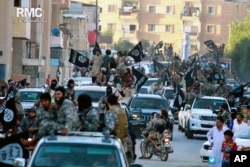As the Islamic State terror group is steadily losing territory in Syria and neighboring Iraq, Moscow fears that many fighters from countries in Central Asia may return home from the Mideast battlegrounds and trigger instability in the region, which could also pose a security threat to Russia.
Analysts confirmed the presence of Central Asian fighters within the ranks of the Islamic State (IS), but said Russia's concerns were overblown.
"It will be very, very hard to imagine more than a handful or two of Iraq and Syria foreign fighters that came from Central Asia ever making it back there," Thomas Lynch, a research fellow at the National Defense University in Washington, told VOA.
"There is not an overwhelming risk to these individuals returning and creating terror incidents in their countries. They went from Russia and they are not coming back to Central Asia," Lynch said.
Stephen Blank, a Russia analyst at the American Foreign Policy Council, echoed Lynch's analysis and said the vast majority of IS fighters from countries in Central Asia did not travel directly from that region to join IS. They were migrant workers in Russia, he said.
"They were uprooted from home, badly treated and vulnerable to Islamic revolutionary appeals," Blank said, adding that those who ended up joining IS were not likely to want to go back.
Central Asia is the third-largest source of foreign fighters for IS, the al-Nusra Front and other terror groups in Iraq and Syria. More than 4,000 fighters from Central Asia have reportedly joined the conflict in Iraq and Syria since 2012.
Lone wolf attacks
Some analysts, however, have not ruled out the possibility of lone wolf attacks. While they admit some returning fighters or IS-inspired homegrown terrorists could potentially pull off lone wolf attacks, they argue those attacks could happen anywhere in the world.
"Just like it doesn't lead to broader instability in London or Madrid, it doesn't have to lead to instability in Almaty, Bishkek or Dushanbe, either," said Noah Tucker, a central Asia expert.
Tucker added that while some fighters might settle down and join the mainstream, others might move on to the next conflict after Syria.
"They tend ... to find another war to fight, rather than go home and try to start a new one from scratch in a country that is no longer really their home," he said. "They have to go where someone will equip them, provide for them and support them to fight in a larger unit, and right now none of these organizations [terror groups] show any real interest in doing that in Central Asia."
Tucker said that of the Central Asian fighters who have chosen to leave the militant ranks and return home, a small number have turned themselves in to their embassies or consulates in Turkey. Others, he said, are not willing to turn themselves in for fear of punishment and are stuck in Turkey.
Dead end?
He said that at this point in the conflict, foreign fighters are faced with a dead end: They either die on the battlefields or are pushed to carry out suicide attacks.
"Retreating Arab fighters in Syria and Iraq are able to disappear and blend back into the population, but Central Asian recruits do not get this option. Their only option is to fight to the death," Tucker said.
Islamic State also does not allow foreign fighters to leave.
"The odds of foreign fighters evading the ISIS-hunting troops, who throw their captured fighters off the roof, seem slim," Brian Williams, a professor of Islamic history at the University of Massachusetts at Dartmouth, told VOA. He used an acronym for the militant group.
As part of a primitive measure, Russia is also reportedly trying to "kill" as many Central Asian fighters as it can, analysts said.
Arastoon Oruclo, a Washington-based Central Asia affairs analyst, believes that Moscow views the Syrian conflict as an opportunity to get rid of "homegrown radicalized individuals" on its soil by facilitating their transfer to Syria and Iraq, where it could "eliminate them in a systematic fashion."
Some Central Asian states have reportedly requested outside help in strengthening their security to deal with fighters, should they return to the region.
But some analysts believe a more concerning issue is the repressive state security apparatuses in some of these countries, not the prospect of returning fighters.
"As a state, if you do not encourage incorporation, encourage economic activities, encourage a reasonable amount of religious freedom, then you create the same kinds of dissatisfaction that tend to lead to radicalism and violence within your own country," said Lynch, of the National Defense University.

